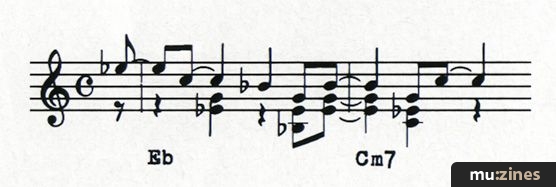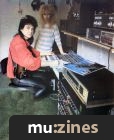Magazine Archive
Home -> Magazines -> Issues -> Articles in this issue -> View
How to write a Rock Song (Part 3) | |
Rhythmic and Harmonic StructureArticle from Electronics & Music Maker, June 1983 | |
Six articles showing you how to write a song (or instrumental) from scratch, explaining the idea of rhythm and the use of syncopation, melody writing, how to fit words to a melody, how to build appropriate harmonic structures, the use of form, how to devise such common devices as riffs and how to use the instruments you have available to play the music you have written. Month by month the lessons you have learned and the exercises you have written will enable you to write a complete piece of your own.
Rhythmic and Harmonic Structure
In this month's article we look at the use of chords, chord sequences and rhythm to provide ways of writing an accompaniment or backing for a melody - which chords to use, how to choose chords that fit together, how to use rhythm for the required effect and how to combine the melody and accompaniment.
We have already seen that it is possible to have a melody which is derived from a chord sequence by making the important notes in the melody belong to the chord used to support the melody at any given point. This establishes a two-way relationship - the melody notes imply the chords to be used and the chords dictate the possible melody notes. In practical terms this means that if you write a melody first, you can start to look for suitable chords for harmonisation by choosing chords that contain the important harmony notes in the melody. Often there is a choice and it will be necessary to experiment to determine which is the most satisfactory chord, both in its effect and in its suitability in terms of the overall chord sequence.

Figure 1a.
The melody in Figure 1a could be satisfactorily harmonised in several ways, the most obvious being to use a simple C major triad, but equally the following chords could be implied by the melody: C7, Am7, Fmaj9, D13 etc. These chords could be used for the whole bar, but if we think in terms of using more than one chord to harmonise this bar, the possibilities are greatly increased.

Figure 1b.
Figure 1b shows four possible harmonisations using more than one chord per bar; this raises a further consideration - harmonic pulse, the rate at which the chords change.
In most styles of music, once established, the harmonic pulse remains the same for the duration of the piece. In rock music it is common for the chords to change at the rate of one per bar. This is obviously a generalisation and a detailed check would reveal every possible pulse rate from one chord for the whole song - as in Smokestack Lightning by Howlin' Wolf, to the one chord per beat of the older type of standard tune such as Spread a Little Happiness, recently recorded by Sting of the Police. It is interesting to note that more complex chord structures such as the latter can be watered down to a slower rate of change, obviously producing a different effect, and vice versa.
For our purposes, it is a good idea to investigate the harmonic pulse of songs in the style in which you want to write. This will give you the rate at which the chords should change in your songs. This can be achieved either by taking them down from the record (if your ear is good enough) or from the sheet music where the chords will be given.
Let's now consider the chords themselves. When choosing chords to fit a melody, it is necessary to experiment with the chords available until the most satisfactory effect is achieved. Experience will enable more rapid selection of chords, but ultimately it is a case of trial and error, playing the melody against the different chords in turn.
Chords are derived from scales, most commonly by building upwards in thirds from the root note, from which the chord takes its name.

Figure 2a.
Figure 2a shows the scale of C major with Roman numerals depicting the degrees of the scale; so C is the first degree of the scale, D the second degree and so on.

Figure 2b.
Figure 2b shows three-note chords (triads) built on each degree of the scale by piling two thirds on top of the root. This gives the chords named.

Figure 2c.
You can continue adding thirds until the root note is reached again, as shown in Figure 2c.

Figure 2d.
Notes in the chord can be altered. Some examples of this are shown in Figure 2d.

Figure 2e.
Figure 2e shows some inversions of chords (where the root does not appear as the lowest note in the chord). This is only a brief discussion of the theory of chord construction and further information is widely available. I include it here though because it is important to see chords as being related to each other through scales and not just as a set of unconnected sounds, because this is helpful when we come to consider chord progressions.
A chord progression is the movement from one chord to another. Chord progressions fall into three main categories: diatonic progression, where the roots of the chords move in scale-wise motion; chromatic progressions, where the roots move by semi-tone steps; and cycle of fifth progressions, where the roots move down by a fifth or up by a fourth.
It is important to realise that these are not the only progressions possible for use in harmony, as even a brief examination of a few songs would show, but many of the progressions commonly found in songs belong to one of these categories, which also provide secure starting points when looking for a good set of chords for a tune.
Here are some examples of chord progressions found in these categories.
Roman numerals are used instead of chord symbols so that they can easily be applied to any key.
Diatonic progressions: I-II-III-II; IV-III-II-I; etc.
Cycle of fifth progressions: II-V-I; III-VI-II-V-I; VII-III-VI-II-V-I etc. Chromatic progressions: II-bII-I; III-bIII-II; I-#Idim-II-#IIdim-III; etc.
These progressions probably wouldn't be used exclusively but a mixture of the different types is often found, for example:
I-IV-V-I, cycle of fifths plus diatonic.
I-VI-II-V-I, cycle of fifths plus the initial step of a third, a common progression which doesn't fit into the groups above.
Examine some favourite songs and take down the chord progressions for your own use. Experiment with these and the types of chord progression discussed above, adding melodies of your own.
Once a melody and chord sequence have been decided upon, the question of rhythm occurs - how to support the melody with a suitable rhythmic accompaniment. One way of doing this initially is to write a simple drum part that would give the feel required.
So for my setting of Mary had a Little Lamb, from last month's article, this medium rock rhythm might be suitable:

Figure 3.
A solid effect can be achieved by synchronising the rhythm of the bass line and the bass drum. When applying the bass drum rhythm to the chords of the first two bars of my setting (Eb and Cm) using alternately the root and fifth of the chords, we obtain the following bass line:

Figure 4.
A secondary rhythm part can be added under the melody using the rhythm of the snare drum. If the melody note belongs to the chord being used, it is often sufficient to add only two notes to complete the triad. This is shown in Figure 5.

Figure 5.
Figure 6 shows a complete setting of Mary had a Little Lamb with piano and drum accompaniment, achieved by using the ideas we have discussed. Examine it carefully and notice the melody and chords in the right hand part and how the rhythm of the drum part is used to provide the rhythm of the accompaniment. Try writing another version using a drum part of your own, writing accompaniments to the melodies and song lyrics, following the guidelines in the previous articles.

Figure 6.
Exercises
1. Write a melody. Experiment with the different chords implied by it. Vary the harmonic pulse.
2. Write out the scales of all twelve major keys. Write in the Roman numerals underneath each degree of the scale. Build triads, sevenths and ninth chords on these roots. Play the chords and listen carefully to the different effect produced by each of them.
3. Write some chord progressions using Roman numerals. Write melodies to fit them.
4. Write chord progressions for your own melodies. Write a simple drum part and from this write a piano accompaniment.
Don't be discouraged if your early attempts don't achieve the results you expect - experience is essential when selecting chords and progressions to fit a melody and to gain this you'll probably make mistakes along the way. It is important to continue the selection process until you find the chords that you like.
Next we shall be looking at the form of the rock song - how verses and choruses fit together and how to write introductions and codas.
Series - "Writing A Rock Song"
Read the next part in this series:
How to write a Rock Song (Part 4)
(EMM Jul 83)
All parts in this series:
More with this topic
Pen Friends - The World's Best Songwriters |
Write Now |
Write Now |
 Selling Your Songs - Songwriters's Special |
It’s My Song - And I'll Cry If I Want To |
The Process |
Beating The System - Systems Music |
Coverage - Lloyd Cole & The Commotions - Cut Me Down |
Billy Bragg - A New England |
Producers' Corner (Part 1) |
 Here At The Front |
Words Up - Better Lyrics |
Browse by Topic:
Arranging / Songwriting
Publisher: Electronics & Music Maker - Music Maker Publications (UK), Future Publishing.
The current copyright owner/s of this content may differ from the originally published copyright notice.
More details on copyright ownership...
Topic:
Arranging / Songwriting
Series:
Writing A Rock Song
Part 1 | Part 2 | Part 3 (Viewing) | Part 4 | Part 5
Feature by Martin Glover
Help Support The Things You Love
mu:zines is the result of thousands of hours of effort, and will require many thousands more going forward to reach our goals of getting all this content online.
If you value this resource, you can support this project - it really helps!
Donations for April 2024
Issues donated this month: 0
New issues that have been donated or scanned for us this month.
Funds donated this month: £20.00
All donations and support are gratefully appreciated - thank you.
Magazines Needed - Can You Help?
Do you have any of these magazine issues?
If so, and you can donate, lend or scan them to help complete our archive, please get in touch via the Contribute page - thanks!















